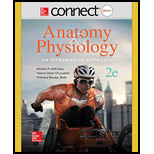
Concept explainers
_____ 1. All of the following are phagocytic cells except
- a. neutrophils.
- b. T-lymphocytes.
- c. macrophages.
- d. eosinophils.
Introduction:
The phagocytosis is the process in which the cells eliminate the pathogens by engulfing them. The substances which are engulfed by the cell may be infectious agents, cellular debris. This is a very common process for food intake in amoebas.
Answer to Problem 1DYKB
Correct answer:
The T-lymphocytes secrete cytokines and activate other cytotoxic T-lymphocytes to invade the pathogens. Therefore, option b. is correct.
Explanation of Solution
Reason for the correct statement:
Option b. is given as “T-lymphocytes”. The T-lymphocytes are the cells which provide protection against the antigens by releasing cytokines and also activate the cytotoxic cells which further release other cytokines. The infectious antigens are eliminated by the cytokines, not by phagocytosis process. Hence, the T-lymphocytes are not the phagocytic cells.
Hence, option b. is correct.
Reasons for incorrect statements:
Option a. is given as “neutrophils”. The neutrophils’ function is to destroy infectious agents through a process known as phagocytosis. It is the process in which the infectious agent is engulfed by the neutrophils. Neutrophils are phagocytic cells. Hence, option a. is incorrect.
Option c. is given as “macrophages”. The macrophages also involve the phagocytosis process in which the engulfed infectious agent is covered to form phagosome and interact with lysosomes to release a residue in the external environment. Macrophages are phagocytic cells. Hence, option c. is incorrect.
Option d. is given as “eosinophils”. Eosinophils also participate in the immune response associated with allergy and asthma and are involved in phagocytosis of antigen-antibody complexes. Eosinophils are phagocytic cells. Hence, option d. is incorrect.
Hence, options a., c., and d. are incorrect.
The neutrophils, macrophages, and eosinophils all are phagocytic cells because they show phagocytosis, but T-lymphocytes releases cytokines to eliminate pathogens.
Want to see more full solutions like this?
Chapter 22 Solutions
Connect Access Card for Anatomy & Physiology
- Phagocytes move through capillary walls by squeezing between adjacent endothelial cells, a process known as (a) diapedesis. (b) chemotaxis. (c) adhesion. (d) perforation.arrow_forwardThe lymphatic system includes all of the following excepta. lymph nodes.b. the spleen.c. the pancreas.d. the thymus.arrow_forwardhematopoietic tissues the cells that undergo mitosis to produce all type of blood cells are known as a) lymphocytes b) hemocytoblasts c) reticulocytes d) megakaryocytesarrow_forward
- An increase in lymphocytes may mean a problem associated with. a. clotting b. immunity C. pulmonary circulation d. systemic circulationarrow_forwardLymph is formed froma. damaged tissue.b. red blood cells.c. excess interstitial fluid.d. white blood cells.arrow_forwardWhich of the following is not a characteristic of inflammation? a. inactivation of macrophages b. increased vascular permeability and edema c. vasodilation d. pain e. influx of leukocytes.arrow_forward
- Which of the following leads to swelling seen in an inflammation? a. Vasodilation b. Complement activation c. Phagocytosis by macrophages d. Increased capillary permeabilityarrow_forwardLymph collected from the lower abdomen, pelvis, and lower limbs is carried by the: (a) right lymphatic duct. (b) inguinal duct. (c) thoracic duct. (d) aorta.arrow_forwardmatch the cytokine with its description. 1.Interleukin-1 2.Interleukin-2 3.Interleukin-12 a. Stimulates formation of TH1 helper T lymphocytes b. Stimulates ACTH secretion c.Stimulates proliferation of cytotoxic T lymphocytes d.Stimulates proliferation of B lymphocytesarrow_forward
- Which of the following is a function of the Lymphatic System? A) production and storage of lymphocytes B) maintaining blood volume by returning fluids from the tissues to the blood C) regulating the composition of the interstitial fluid D) all of the above.arrow_forwardStem cells responsible for the process of lymphopoiesis are located in the (a) thymus and spleen. (b) lymph nodes. (c) red bone marrow. (d) a, b, and c are correct.arrow_forwardIn some cases of breast cancer, many of the axillary lymphnodes are removed. Why are injections not usually doneon the affected arm?arrow_forward

